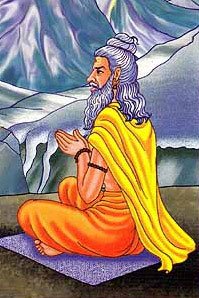Parvasandhi, Parva-sandhi, Parvasamdhi: 6 definitions
Introduction:
Parvasandhi means something in Hinduism, Sanskrit, Marathi. If you want to know the exact meaning, history, etymology or English translation of this term then check out the descriptions on this page. Add your comment or reference to a book if you want to contribute to this summary article.
In Hinduism
Purana and Itihasa (epic history)
Source: Cologne Digital Sanskrit Dictionaries: The Purana IndexParvasandhi (पर्वसन्धि).—The last day of the Kṛṣṇa and Sukla Pakṣas;1 fit for the rituals of agniādhāna.2

The Purana (पुराण, purāṇas) refers to Sanskrit literature preserving ancient India’s vast cultural history, including historical legends, religious ceremonies, various arts and sciences. The eighteen mahapuranas total over 400,000 shlokas (metrical couplets) and date to at least several centuries BCE.
Dharmashastra (religious law)
Source: Sacred Texts: The Grihya Sutras, Part 2 (SBE30)Parvasandhi (पर्वसन्धि) refers to the “juncture of the two phases of the moon”.—That moment on which sun and moon are, as the Hindus said, at the greatest distance from each other, is called the parva-sandhi, the juncture of the two phases of the moon. Thus the name of paurṇamāsī (full moon) belongs to the last day of the one and to the first day (pratipad) of the other phase, and both days might be called paurṇamāsī.

Dharmashastra (धर्मशास्त्र, dharmaśāstra) contains the instructions (shastra) regarding religious conduct of livelihood (dharma), ceremonies, jurisprudence (study of law) and more. It is categorized as smriti, an important and authoritative selection of books dealing with the Hindu lifestyle.
Languages of India and abroad
Marathi-English dictionary
Source: DDSA: The Molesworth Marathi and English Dictionaryparvasandhi (पर्वसंधि).—m (S) The junction of the 15th and 1st of a lunar fortnight; or the precise moment of the full or of the change of the moon.
Marathi is an Indo-European language having over 70 million native speakers people in (predominantly) Maharashtra India. Marathi, like many other Indo-Aryan languages, evolved from early forms of Prakrit, which itself is a subset of Sanskrit, one of the most ancient languages of the world.
Sanskrit dictionary
Source: Cologne Digital Sanskrit Dictionaries: Shabda-Sagara Sanskrit-English DictionaryParvasandhi (पर्वसन्धि) or Parvvasandhi.—m.
(-ndhiḥ) The full and change of the moon, the junction of the 15th and 1st of a lunar fortnight, or the precise moment of the full and change of the moon. E. parva a joining of the month, and sandhi union.
Source: Cologne Digital Sanskrit Dictionaries: Yates Sanskrit-English DictionaryParvasandhi (पर्वसन्धि):—[parva-sandhi] (ndhiḥ) 2. m. The full and change of the moon.
Sanskrit, also spelled संस्कृतम् (saṃskṛtam), is an ancient language of India commonly seen as the grandmother of the Indo-European language family (even English!). Closely allied with Prakrit and Pali, Sanskrit is more exhaustive in both grammar and terms and has the most extensive collection of literature in the world, greatly surpassing its sister-languages Greek and Latin.
Kannada-English dictionary
Source: Alar: Kannada-English corpusParvasaṃdhi (ಪರ್ವಸಂಧಿ):—[noun] the point of time marking the end of a full-moon day new-moon day when the mooṇs phase starts increasing or decreasing.
Kannada is a Dravidian language (as opposed to the Indo-European language family) mainly spoken in the southwestern region of India.
See also (Relevant definitions)
Partial matches: Parva, Sandhi.
Full-text: Parvasamdhi, Agnyadhanakriya, Padasamdhi, Nishakara, Parvvasandhi, Paurnamasi.
Relevant text
Search found 3 books and stories containing Parvasandhi, Parva-sandhi, Parvasamdhi, Parvasaṃdhi; (plurals include: Parvasandhis, sandhis, Parvasamdhis, Parvasaṃdhis). You can also click to the full overview containing English textual excerpts. Below are direct links for the most relevant articles:
Karmic Astrology—a Study (by Sunita Anant Chavan)
Part 2.2.3 - Study of motions of Sun and Moon < [Chapter 2 - Jyotiḥśāstra and the Concept of Karman]
Part 2.2.5 - Peculiarities of Gaṇita (calculations) < [Chapter 2 - Jyotiḥśāstra and the Concept of Karman]
Apastamba Yajna-paribhasa-sutras (by Hermann Oldenberg)
The Skanda Purana (by G. V. Tagare)
Chapter 220 - Importance of Gajacchāyā < [Section 1 - Tīrtha-māhātmya]